
By Shiloh Richter
20 February 2023
Willa’s Divine and Truman’s Heart of Darkness
Truman Capote didn’t write BREAKFAST AT TIFFANY’S. Willa Cather did. Truman Capote stole it, and Audrey Hepburn knew it. Part IV. It’s the caper of the millennium and it’s ON. (Just ask John, Adele, Gigi, Rihanna, Katy, Kim, or Reese . . . )

Adele on the Huckleberry River in her “I Drink Wine” video
Willa Cather was working on an electrified, inspired trajectory in her writing from the moment of her realization in the American Southwest in 1912 and it matching the rootedness she felt in the land and culture in Provençe she had discovered on her first trip there in 1902 (already well-versed in its literature), but here it was full of spirit and possibility, wild, free and boundless; in Provençe it was carefully rooted, cultured, tended, religious, even in a secular way. The Southwest gave her the grounding, energy, and the fire she needed for it. She wanted both insights, to open it here, the old world and the new, because the new meant she could take away the former restrictions she was seeing past and what she was feeling of her very self and what she could create through her writing while coming from the foundation of the writers before her: The ‘old world’ also meant the inheritance of art, literature, and history and a trajectory she could see and its careful care by the masters who also saw embodiment and America as the possibility of opening the long-sought reality where harsh judgment and brutality did not rule.
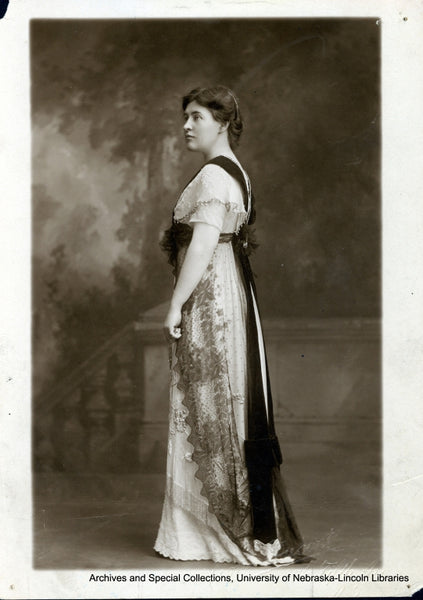
Photos: Willa Cather c. 1910 in New York, two years before her first trip to the Southwest. (Below) Cather at a dinner party in New York City in honor of Mark Twain's 70th birthday. C. 1905, The Willa Cather Archive, University of Nebraska-Lincoln.

This was added to her insight to take the feminine further from a sense of her own spirit she was born with, a point she saw beyond from, for example, where Mark Twain had brought Huckleberry Finn who was headed off to freedom into the unknown further down the river. She knew she could go further. (The Adventures of Tom Sawyer was published when she was three years old; by nine Willa had moved to the vast open prairies of Nebraska where she felt self was erased–and probably what began to open her to this sense of Place, and at that time when she was eleven Adventures of Huckleberry Finn was published with Huck her age. It was in the air. Willa, as we know, was not daunted by gender expectations.) This spirit is an added dimension of what she was seeing into the feminine American possibility and what that meant to the opening of this different course for its culture. These personal distinguishing characteristics of her as an individual are also what Truman Capote was trying to copy by making Holly Golightly’s past a Huckleberry Finn kind of character (“and a bit of a dyke”) (and making up personal stories about his own past on a riverboat to match), and Holly having a meet-up on the river with a likewise feral cat, and so he was not only taking Willa’s words, but her life and personhood as well, trying to take the very fire of inspiration (and like the other male writers, not knowing how to capture it–it can’t be captured because it IS the thing ITSELF that writes IT) and turning it into his dark pathology, and this being the very reason George Axelrod was putting the fire-on-the-mountain inspiration back where it belonged, back directly to Willa, and also knowing by doing so he was re-opening up that magic–what was actually in Willa’s work that is astoundingly embodied and fortuitous and quite obviously still alive in this Moment with its same renaissance fire. The feminine spirit was the way to do that, as Willa was demonstrating, and no one had that more than Audrey with her vulnerability matching her courage, and her consciousness with internal drive to make the difference by the wonderful–internal and external–position of “power” she had been given. That realization of spirit is what Cather had written—and further–its breaking the former acculturated foundations of culture to redefine and rebirth it, nurture the new foundation and infuse and inspire it with a new embodiment–a radical new “arriving to the new world” into a culture truly alive, inspired itself, so much more so than the outwardly forceful and dominating one that came before in the “conquering” and tearing-down mindset for gain while it actually destroys everything. Willa was bringing this to a very physical, real, and grounded realization, the feminine-in-the-Body which infuses extraordinary possibilities of what was not “allowed” before. Willa was an editor in New York City at McClure’s, one of the top magazines in the country, but opened by the Southwest she lessened her ties to the workload because the writing had stunned her into its central importance in her existence. It meant not having the security of the money from the structure and believing in the writing. (Her “The Bohemian Girl” was published as she got home from this trip.) (And in that way writing matches confidence in Beingness and that matched what she would write.) At the same time, the same trip home from her first trip to the Southwest (on the way home in June 1912 she came through near here, the old railway line through Capitan, NM, through the Lincoln National Forest), and soon after, by September, would go to her new apartment at Number 5 Bank Street in Greenwich Village with its “old-world charm,” which would be the base of her writing that would come from exactly this illumination. In her letters about what happened in the Southwest Cather wrote to the owner of McClure’s described by her biographer,
“She had not written a line since leaving the East, but she had returned with such a head full of stories that she was dreaming about them at night. She had ridden and driven hundreds of miles in Arizona and New Mexico and McClure would not recognize her, she was so dark-skinned and good-humored [ . . . ] She was now happier than she had been since she was a youngster. Those weeks off in the desert [ . . . ] took all the kinks and crinkles out, and she felt as if her mind had been freshly washed and ironed and made ready for a new life. She felt somehow confident, as if she had gotten her second wind. In describing her return to civilization to [a close friend] she put it another way. The Southwest had been so big and so consuming that she was now glad to be back in the East, where she could slowly come to herself without that swift, yellow excitement to think of. Before she left, the real meaning came to her of a sentence she once had carelessly read in Balzac: ‘Dans le desert, voyez vous, il y a tout et il n’y rien; Dieu sans les hommes” (In the desert, you see, there is everything and nothing; God without men’). That sentence really means a great deal, she wrote. She was sitting mournfully beside the Rio Grande one day, just outside a beautiful Indian village, Santo Domingo, when she looked up and saw that sentence written in the sand” (Woodress, Willa Cather: a Literary Life, 14-15).



Photos (above): John Mayer in a Southwestern jacket performing at the Power of Love benefit concert 18 February 2023; Reese Witherspoon 19 February 2023 on Instagram; Blooming Persephone: Katy Perry on the 21st season of American Idol; My Fair Lady Gigi Hadid Instagram post 19 February 2023 on upcoming season of Next in Fashion.
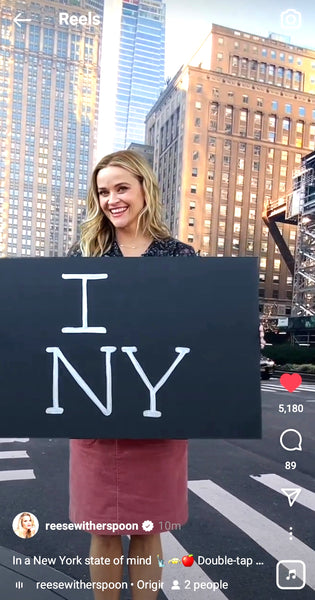

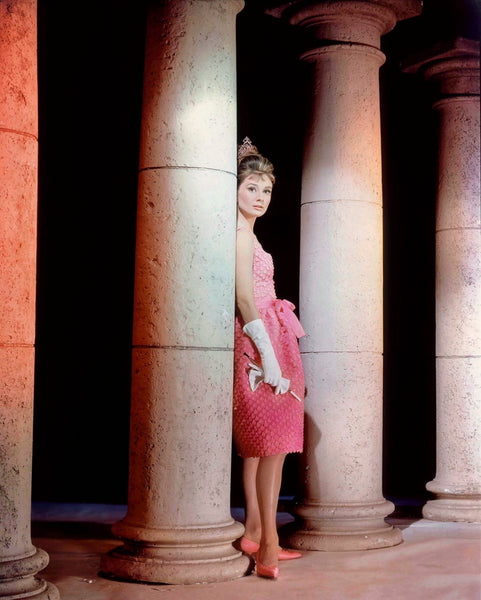

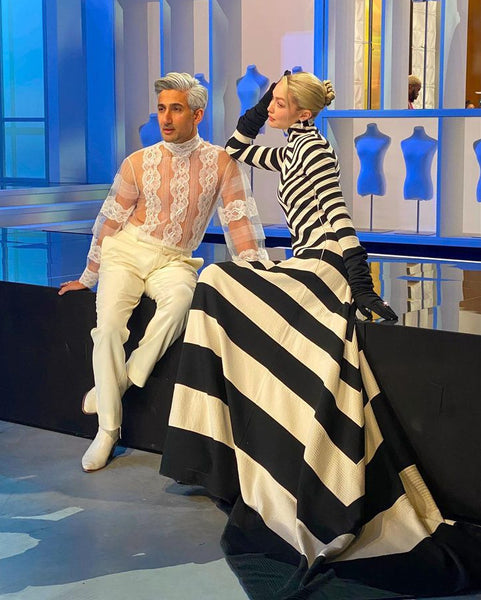
She was carefully looking into the feminine and culture and seeing something astonishing that culture wasn’t seeing (bound as they were to seeing forms as they did): like the Southwest, the physical had very much to do with the spirit: the physical was indomitably the spirit and that matched her own realization–this physical was not removed from the divine. And this astounding self-realization could be put to words, created, redefined in her writing. This path breaking through culture into a wild blooming was possible of this full realization. From that moment forward she was seeing into things beyond the acculturation built around the feminine and she was breaking it free. Buddhism calls it one of the doors to liberation, signlessness. And so here is the biggest “no-no” she then breaks: she shows the manifestation of the divine AS the feminine which it is, in the female Body. This radical long-coming breakthrough is what Audrey actually accomplishes in Breakfast at Tiffany’s, despite a pathological criminal trying to steal Willa’s illumination so he can be seen as a “writer” and forever in the spotlight, trying to manipulate it to his dying day. This happening of bringing the movie version of Truman’s plagiarized novella back to her truly is back to her COMING, APHRODITE!, and there SHE IS, Audrey humbly, beautifully, more iconic of the female in culture than anything ever before, and the very reason she was doing it was not to be in a movie or to gain more attention but because she personally knew a world ripped apart by war, knew a dad leaving and not caring, knew what it meant to have a child in this world and to be a mother, knew who was starving and going without, and that influence was about setting things straight, no matter who tried to manipulate, by caring. The nurturing of “Mother Mary'' separated out into just the image of an icon that doesn’t touch or recognize Beingness or help “forms” with suffering but from afar but keeps the institutions in control and rich is one thing. Knowing what being a mother is and with influence from a very different kind of realization of power, is something else entirely. Embodied is everything. And Audrey was/is THAT. Her Being is no less powerful because the Church doesn’t recognize it. What is forbidden is an acculturation, a foundation of culture that says narcissistically, “NO, GOD is WHITE MALE UP IN THE SKY BECAUSE I SAID SO AND I WROTE IT DOWN AND I’LL KILL YOU IF YOU CROSS ME.” Willa was carefully crossing this huge forbidden cultural Crossing from her own Being. She knew the inenarrable had to be known within her, what she had discovered in the literature and in the Southwest that couldn’t be stopped, and how carefully in 1912 it would have to be shown to be naturally structured, very naturally already true, but also very ready to shift culture. What Audrey believed in was the value of humanity. Willa was daring her life and work on what she saw in the art and what she had found in Place, in the Here and the Now. And here is a wild fact: Audrey had just made a movie, The Nun’s Story (1959), the year before making Breakfast at Tiffany’s that artistically accomplishes the same thing, her very image backgrounded with Michelangelo’s Bruges Madonna and Child (a work he did right after he had created the St. Peter’s Pieta in 1500) with the child radically stepping out with being given life, not crucified right there at the altar table (or what humanity will do to him). Audrey was born to it right there in Belgium. And fortuitously for this Moment, Willa wrote and was inspired by the ability to break through culturally of singers, musicians, and actresses.

Photo (above) Audrey with Famous on the set of The Nun’s Story; (below): Opera Soprano Olive Fremstad who provided more inspiration for Willa’s The Song of the Lark. Her name and career are a wild foreshadowing of Ian Falconer’s opera-singing, red-lipstick-wearing, cat-carrying Olivia which Taylor Swift plagiarized for the theater Red “Era” with her trying to trap and drown-out artists in an untrue and very harmful past by trying to take over the narrative of other artist’s lives, and to keep that false, narcissistic past as dominant–just as Truman Capote was trying to do by appearing on talk shows and lying as he died. What it means to bring the very alive Past into the Present Moment is that it is fully as alive in Beingness as it was in the Moment it was in Form, proving the breakthrough to the eternal of the artist and the work. And in that way, the Past is alive in the Present, invigorating it with the wild inspiration of “no birth, no death.” Audrey’s power to change the world is very much alive with her smiling in this Moment. Her “power” of Beingness isn’t daunted. It’s a very alive “dharma body.”

Seeing what she sees into, knowing it is fated and coming directly from ancient and Renaissance art and literature, too, there is nothing that can forbid Willa, but the approach had to be careful, understated, mindful, and accomplish its task in taking the feminine in the physical realization of the natural source to its natural expression of the state of the divine in the Body–and infusing culture with this much more radiant inspiration, the alive Female. Just as the male writers had emulated her and she had gone further in expressing the feminine, she could do that with the structure of culture being a female writer because she could also see it in the literature and art that came before leading to this. One of those works is the Divine Comedy and Dante first had to show how Hell on earth is created before he could show what makes it Paradise (or Alicia Key’s NYC) through illumination and Beatrice. (I have another series of articles running on Dante’s Inferno), but it must be mentioned here about the Fraud and Betrayal which forms the very foundation of the worst of Hell, or “How to Create Hell on Earth for Everybody.” Before the Poets Dante and Virgil descend to the circles of Fraud, Virgil has Dante take off the cord from his waist that was tying his robe and which Virgil then dangles down as a lure for the fraud monster, Geryon, to come swimming up from the lowest abyss. Since Virgil has been to hell before himself, he knows that whenever this lure is dangled, Fraud will appear. This happens right at the end of the river of tears from Crete which then forms a waterfall down into the abyss. In other words, what has been turned into a fetid, very smelly flow from life (and the leaving of the feminine) and Poetry (from leaving the Poets in limbo to plagiarism, to selling this sacred for money and power, etc.), is showing what it has come to, who is its lowest: Fraud with Betrayal of given trust. (I can’t wait to write about John’s “Gravity” and Harry’s House and Ariana Grande’s there, flipping the worlds when Dante and Virgil climb down Lucifer’s body. Yikes, the literalism!) And there is something else here: it is the flow of Dante’s robes that is opened at the very waterfall, the robes of the sacred, the Poet of the Divine Comedy and the Poetry itself, that has been turned here creating a hell, and when that sacred robe is opened to flow, undoubtedly the entity of contortion, the fraud monster, the greedy, will appear, and Virgil knows it. It happens every time. It happened to Homer in 800 B.C. It happened to Virgil in 19 A.D. And Dante was showing that he knew it had happened to the masters who came before in his line. While he’s showing this, however, he’s also retrieving it from the plagiarism and fraud because we know his Poetry is going further.
The very difference isn’t in the forms people see, we think we know what those are. Pony-tails copying Audrey is just harmless inspiration, right? “Innocent enough.” (But it didn’t come from inspiration, it came from trying to force, own, and control.) The difference is the Being. The spirit is the difference. And a culture who doesn’t care to know the difference past surfaces, past forms (as Homer shows), is, in short, deceived. And because of fame (as narcissism, not “opening to eternity”) and a weird notion that narcissism could be immortality (other than eternal hell) and in that way somehow more than human (even though the ancients knew they are always caught in this ‘underworld’ of the pent-up hatred in the deep psyche–the harm to culture as if Perisphone could never surface to bring the bloom of Spring), and with that view of fame, the view of the eternal being alive is very askance and makes for a skewed culture with strange, empty values, just so long as someone manipulates and remains “famous.” But when the empty greed sense that something truly is immortal, something extraordinarily beautiful, real, and true, (as Taylor Swift dubiously got into the door of John Mayer in the studio by not letting up on the tracking and plagiarism, and thus opening the Poetry to her to further fraud, and giving her that personal trust), with this “dangled” in front of them, the fraud monster will come and those circles of Hell show exactly what Dante knows they will do. It was too much to hold in front of them. And Truman knew it and he wasn’t about to stop himself from the biggest grab there was, the very essence to which Willa had given her life and world-changing work. No less than Hemingway, Fitzgerald, and Faulkner were quietly attesting to her highly-influential genius. But Truman and Taylor wanted to own it all, and the way to do that was fraud and betrayal.

Photos: Kim Kardashian for DOLCE&GABBANA/MERT & MARCUS, posted 18 February 2023.
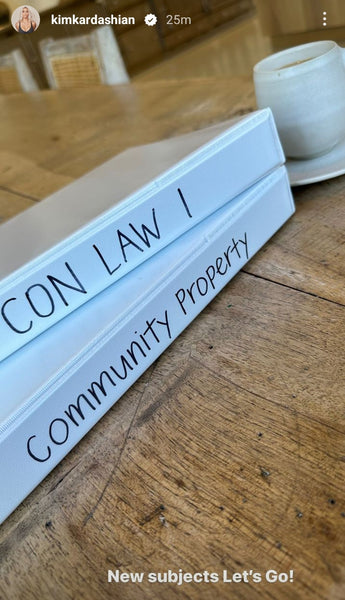
The very opposite of Willa’s realization in the physical Being, the negation of it, is Truman Capote who was an entity who desperately needed to intimately infiltrate others’ personal lives, find vulnerabilities even if it was just their kindness or openness, and tear that person’s life apart, tear everything down (like trying to light a lighter to it for spectacle) to get himself in the spotlight and manipulate and lie to keep himself there making his pathology the very drive of fame and attention, and by proving he would go as far as he could to maintain that center stage, even while millions were being slaughtered in Vietnam. It did not matter to him. It only made him more “fearless,” less daunted. Only he and his status mattered and the sham he was pulling off. Oddly, the surface appearances of fame white-washed the sociopathic that was happening: people talking right past it as if it were somehow just eccentricity, a “writer”–even lightening it because it was “entertainment,” and how could that be truly evil? It’s just a book! Truman’s status and reputations weren’t even tarnished as one of his victims, Ann Woodward, committed suicide, his Deliberate Cruelty, as the 2022 book precisely named it. Even after the outright plagiarism and carrying the scam from the publication of Breakfast at Tiffany’s in 1958 into selling the movie rights and the making of the movie, Truman said (making himself the center and the victim like Taylor Swift), “Paramount double-crossed me in every way and cast Audrey.” (Wasson, Fifth Avenue, 5 A.M.). “ME!” “Hi, it’s me, I’m the [FOCUS OF THE] problem.” And all plagiarized. The admired “tenacity” could change its face to victim when necessary.

Photos: Truman Capote posing as the writer.

Truman had an obsessive appetite for fame and a histrionic demand for attention at anyone and everyone’s cost—even a morbid need to publicly humiliate by infiltrating information: “‘Truman started his day [by] getting a cup of coffee and talking to gossip columnists,’ Harrington recalled. ‘He would trade all the gossip. They would discuss all the happenings, the secrets.’” The portal into their living rooms. He even personally hungered for his ‘writing’ victims to die from his In Cold Blood so that he would have a best seller, as shown in The Capote Tapes documentary. Truman hoping to get people murdered through the executions is not far from Taylor Swift placing her songs for covert dark attention for example in the Season 3 finale for the Netflix series You, placing her own voice to the murder of the wife, and doing so with plagiarized personal details (“Exile”), and actually NEEDING people (me) to die, or when the female killer gets away with murder in Where the Crawdads Sing, plagiarizing the Grateful Dead’s song “Black Muddy River” (and receiving critical adulation for it) and using similar to John’s personal attire, while wanting to be able to take public credit for hurting John and wanting to be seen as covertly walking away unindicted with the hateful backing of her fan base. Or trying to still claim New York City in the opening of The Secret Lives of Pets. The obsessive need to own, control, dominate, and invade for fame at any cost, above everyone, is a need to harm in order to be the only Special. But all of those too were plagiarized ideas. A John Mayer fan account that Taylor heavily tracks and copies had been posting about the obsessive series You.

Or because of where I live, somewhat isolated in New Mexico, and publishing books from here as in Where the Crawdads Sing. There has not been one word of originality from her. None of it was thought up on her own. There’s no fire of inspiration. There’s no carefulness, mindfulness, or insight. It’s a deviant appetite for others’ personal details and the need to sell it, to sell the sacred, to kill it, to rip it apart, only so that it means keeping herself seen as, appear to be, the most daring celebrity there is and the fans believing this sense of “what a strong will she has” is to be admired--and they emulating that aggression on-line (only 1 in 3 teenage girls have recently thought about suicide), when in fact, narcissism appears as a knowing what one wants or as a strong, formidable will (and people then tend to follow it)–when it doesn’t come at all from knowing one’s own Being. It’s a will and need to bring harm and to gain attention from it. The “best” kind of attention from that is when it can plagiarize the best and the brightest, and when it can go further and get away with fraud, or when it can go even further and perpetrate an unthinkable personal betrayal, the most devastating harm of all, and that is what they lust for just as in the bottom of Dante’s hell. And so, when it is shown the most beautiful, the most sacred, the emptiness inside longs for what it can never have and never be and so it wishes to kill the thing it purports to love.
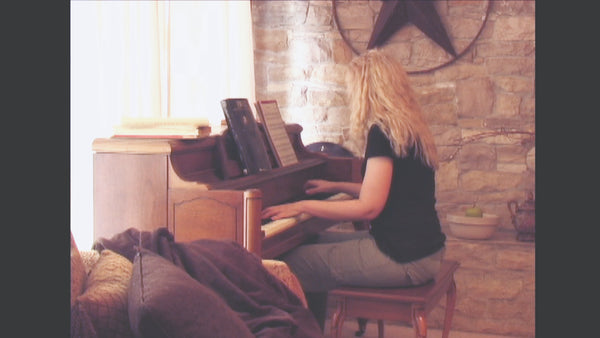
Photos: Stills from a personal video I made for John upon returning from NYC in July 2010 of me playing the piano, my dogs, and the interior of my home. The bottom photos show Marti Bofarull’s painting “Meet Me At” showing Taylor’s need to personally invade and plagiarize








It’s the attention need to be the one capable of doing the harm to give the fame more substance, more fateful, anything for it to be more “real” and “provable.” Real can only be in the Moment, as Thich Nhat Hahn says, and this “appearance” and surface manipulation isn’t true or real. These crimes are very much like infiltrating a town and writing In Cold Blood, Truman even using a collaborator in Harper Lee and getting by with it. Taylor has been doing it from the beginning, appearing so innocently in the woods as where I live in the video for “Safe and Sound” while referencing graves and using the Civil Wars because of my name, Shiloh, a Civil War battle, something she wouldn’t know except of my writing to John–infiltrating the personal. This perpetration continues daily to make it more “daring,” as in standing up at the 2023 Grammys for Harry Styles (after exploiting him for over a decade) because I speak out for and protect John as much as I can in this writing because I know what happened. Hers is a seed full of hate that she waters every day and sells to the public as a vision of what fame is and what power it has, and then lives in that hate trying to find ways to manipulate the fraud and make it look more real. And then there’s Willa and Audrey. And this very Moment. And the very formidable culture shift they intended with their whole Beings and works. When I took the trip to see John in New York City in July 2010 before leaving for the Southwest the miracles were happening everywhere. They were very much alive. It turns out, that was just a prelude. “We pick up in New York City . . . “